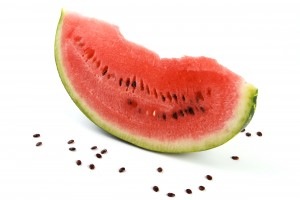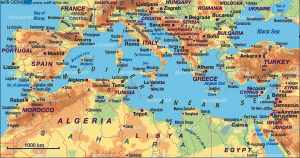 Here’s the reason: food that has a high water content — like cucumbers, soup (especially broth-based soup), and, you guessed it, watermelon — make you feel full and, they’re usually relatively low calorie foods.
Here’s the reason: food that has a high water content — like cucumbers, soup (especially broth-based soup), and, you guessed it, watermelon — make you feel full and, they’re usually relatively low calorie foods.
How great is it that something as nutritious and calorie friendly as watermelon is such a treat? Juicy watermelon has certainly finished off lots of camp meals and family picnics and dare I mention the college special: watermelon infused with vodka? And, how pretty are those intricate carved watermelon baskets filled with watermelon, cantaloupe, and honeydew balls? Very labor intensive. My mother was good at that.
I just came back from a trip to Greece where just about every lunch and dinner ended with a beautiful platter of red, ripe watermelon. Totally satisfying, thirst quenching, and an important component of the Mediterranean diet.
A Melon With History
The first recorded watermelon harvest was in Egypt, nearly 5,000 years ago. Now you can find more than 1,200 varieties grown in 96 countries. Watermelon — 92% water and 6% sugar — is a cousin of cucumbers, pumpkins, and squash and is the most consumed melon in the US, followed by cantaloupe and honeydew.
Some Watermelon Trivia
- Watermelon, with its water content, is a volume food. It fills you up and quenches your thirst and is great for weight control.
- One wedge (about 1/16 of a melon, 286 g) has 86 calories, no fat, 22g carbs, 1g fiber, and 2g protein.
- 10 watermelon balls (122g) have 37 calories, 0 fat, 9g carbs, 0g fiber, and 1g protein
- 1 cup of diced watermelon (152g) has 46 calories, 0g fat, 11g carbs, 1g fiber, and 1g protein
- Two cups of red flesh watermelon chunks supplies 25% of daily vitamin A, 30% of daily vitamin C, B6 (6%) of B6; 8% potassium, 4% phosphorus, 8% magnesium, beta carotene, and lycopene.
- Watermelon’s inner rind is edible and has a bunch of hidden nutrients. The outer rind, also edible, is sometimes used as a stir-fried or stewed vegetable or as a pickled condiment.
- Look for a watermelon that’s firm, symmetrical, and bruise, cut, or dent free. It should be heavy for its size and its underside should have a creamy yellow spot from where it sat on the ground while it ripened in the sun.
- Whole melons will keep for 7 to 10 days at room temperature but lose flavor and texture if they’re stored too long. They’ll keep for three to four days in the fridge after they’re cut.
Unusual Watermelon Salads
I recently had a salad made with arugula, yellow watermelon chunks, grilled red watermelon slices, pistachios, grated ricotta salata, and balsamic dressing. It was awesome.
Here’s another salad I frequently make. I’m not too precise with my measurements and it still tastes fantastic:
Mediterranean Watermelon Salad (adapted from watermelon.org)
Ingredients:
- 6 cups torn mixed salad greens
- 3 cups cubed seeded watermelon
- 1/2 cup sliced red onion
- 1/3 cup crumbled feta cheese
- 1/2 cup watermelon vinaigrette
- Freshly ground black pepper
- Mint sprigs
Watermelon Vinaigrette:
- 2 tablespoons honey
- 1/4 cup pureed watermelon (puree chunks in a food processor)
- 2 tablespoons white wine vinegar
- 1/4 teaspoon pepper
- 1 teaspoon olive oil
Directions:
Make the vinaigrette by whisking all of the ingredients together. Store it in the refrigerator and shake well before using. Makes about 1/2 cup.
In a large bowl, mix all of the salad ingredients except the vinaigrette, pepper, and mint. Just before serving, toss the salad mixture with the vinaigrette. Garnish with pepper and mint sprigs.
Makes 6 servings. About 75 calories per serving.






